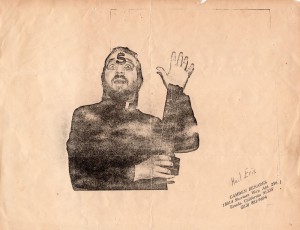
Photo courtesy of John F. Carr.
During the Korean War, Overton served in the Navy and somehow finagled a tour of duty in Jamaica, spending most of his time, during the conflict, romancing beautiful black women. Due to these pursuits, Overton developed such an excellent Jamaican accent that when he returned to the states he hosted a local African-American sponsored radio show in Los Angeles, appearing as “Trinidad John.”
According to Discordian mythology—or at least Kerry Thornley’s version—it was following Overton’s first acid trip in the mid-60s that he decided to change his name to Camden Benares, the idea of which was to bring the teachings of the East into the West: “Camden” for Camden, New Jersey, and Benares after Benares, India, paying allegorical homage to the city where the Buddha delivered his first sermon.
In Europe, Camden is still considered a leading authority on Zen, and his books have been published in German, Dutch, and several other languages. He wrote a total of three books in his Zen series which included Zen Without Zen Masters, A Handful of Zen and his final—and as yet unpublished memoir—Riding Buddha’s Bicycle, finished shortly before his death in 1999.

Courtesy of the Discordian Archives.
Throughout Riding Buddha’s Bicycle, Benares stressed that his method of peddling might work for some in some instances, but most likely not for everyone in all instances and that it’s incumbent upon each and every prospective Zen peddler—who mounts Buddha’s bicycle—to chart their own course of discovery as they move along at different speeds and vectors. Camden simply encouraged his readers to consider his methods and to either use them or discard them, as they saw fit. There are many paths up the mountain…
At the outset of his studies, Camden deeply contemplated the two schools of Zen thought, and which would be the most appropriate for him to pursue: 1) The School of Gradual Enlightenment, as opposed to: 2) The School of Sudden Enlightenment, accompanied by that blinding flash of satori that leads to illumination.
Camden decided the former—Gradual School of Enlightenment—was a more practical and attainable approach for him personally, and “would consist of gaining knowledge by seeing into one’s own nature and having a series of insights that would produce an enlightened state equivalent to the experience of sudden enlightenment…”
While Benares’ aforementioned LSD trip may have certainly been a catalyst to his mounting of Buddha’s bike, other episodes in his life were of equal or greater importance, such as a pivotal life-after-death experience, followed not long after by an ill-fated love affair. Each of these episodes set Camden forth on a quest of self-examination and personal exploration, to ultimately cultivate his own self-styled Samadhi, and to make himself a more tuned-in soul.
For Camden, it was more about the journey than arriving at any ultimate destination, for who really knows, among us, if there truly comes an end to consciousness, human or otherwise? It was what he discovered along the way, and living life to its fullest, that was forefront in Camden’s consciousness, as such seemingly trite maxims as “being in the now” and “living for the moment” truly came into focus for him—due to a health crisis he experienced in his early 20s—when given just mere months to live. My guess is that, at least in the back of his mind, Camden must have felt he was living on borrowed time, and that it was critical he make the most of each precious moment at his disposal, however fleeting they may have been, while riding Buddha’s bicycle.
3 replies on “Camden Benares: Riding Buddha’s Bicycle”
Hi there. I have been leaning Karmic Tarot from Camden Benares introduction of William C. Lammey’s work. I cannot seem to find any information on William and I have only just now found this article about Camden. Have you done much more research into the findings of these two men and the knowledge they held about our physical/ material plane? I am a writer and I believe that there I have a story to share. Please reach out if you have any information on these two men and if you could possibly help me discover something that has been laid to rest for a long time. Thanks. Joey.
Any idea when or if this will ever be published?
Sadly, at this point, I don’t expect it ever to be published.